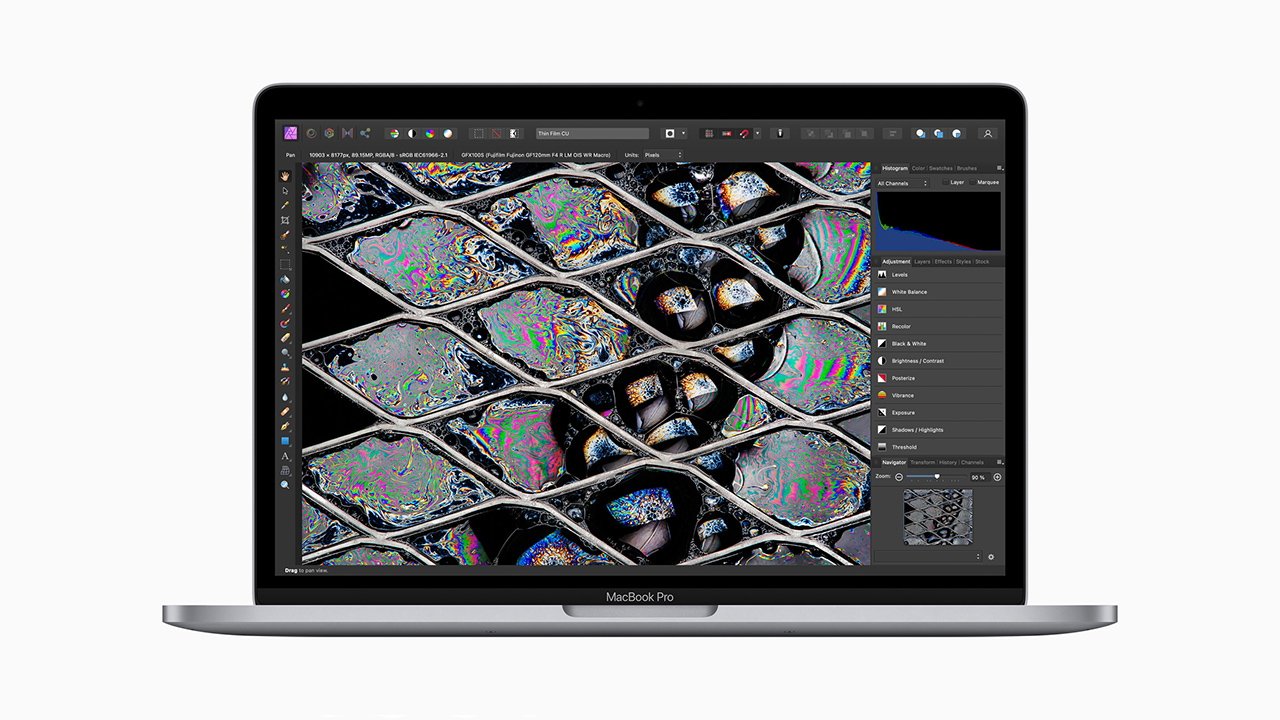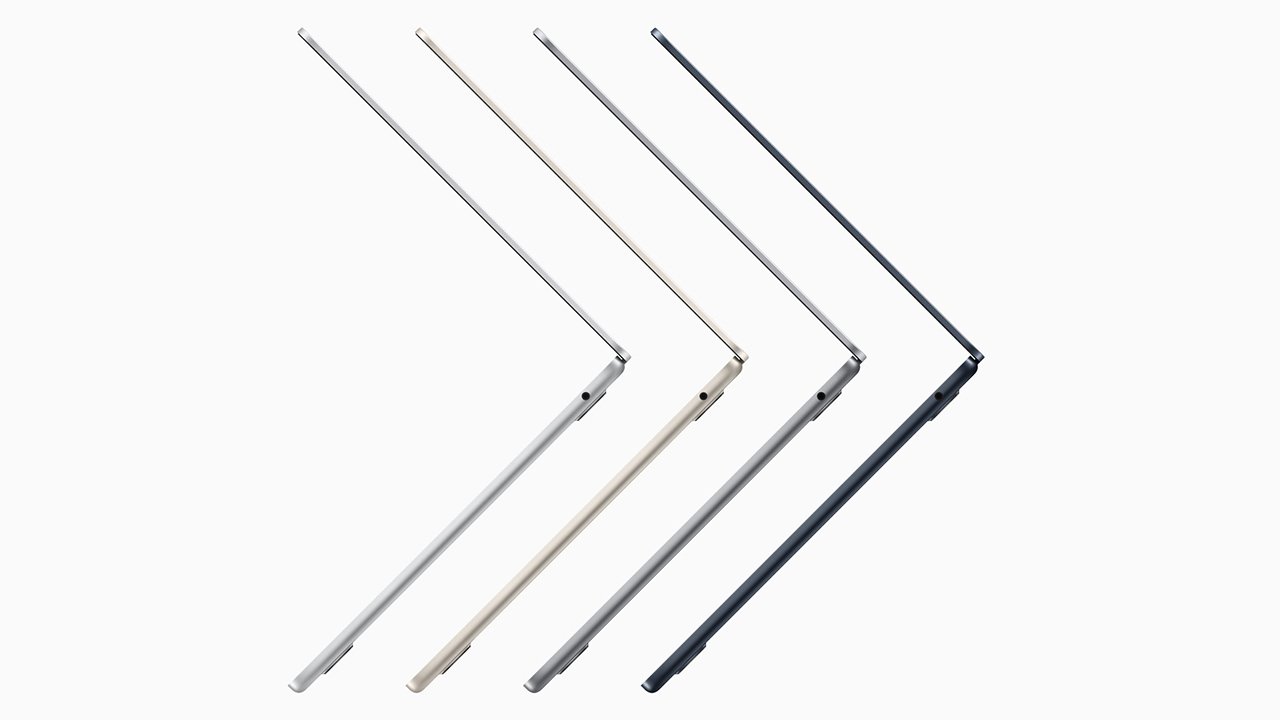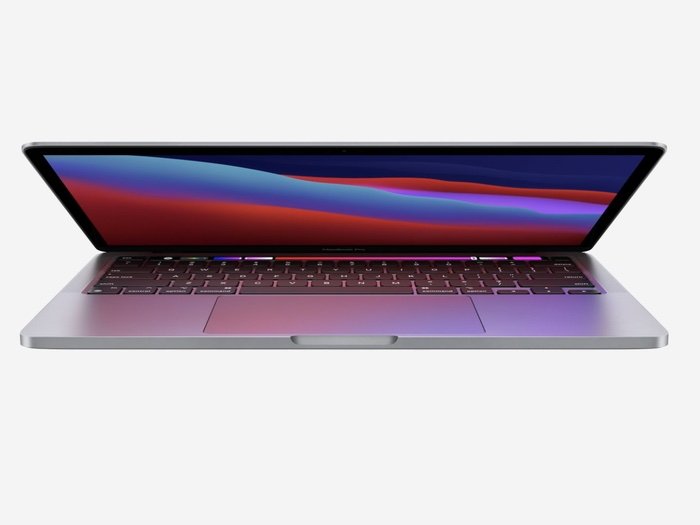There are only a few good reasons to buy the new 13-inch MacBook Pro
The 13-inch MacBook Pro with an M2 chipset occupies a weird space in Apple's current Mac lineup -- and there's little reason for most users to buy it.

13-inch MacBook Pro
During its WWDC 2022 keynote on Monday, Apple unveiled its M2 chipset that powers a newly redesigned MacBook Air. Alongside a wealth of new features, the 2022 MacBook Air has also received what is the most significant design overhaul to the model in years.
Weirdly, Apple also debuted a new 13-inch MacBook Pro model with the upgraded Apple Silicon. Unlike the MacBook Air, however, the new MacBook Pro doesn't feature really any changes from its predecessor.
Here's why the new MacBook Pro is a bit of a head-scratcher, and why you're probably better off choosing another Mac.
When it comes to the updates each model received, that's where the similarities end.
The new MacBook Air has an revamped design that's much thinner than its processors. It has an upgraded 1080p HD webcam, an upgraded four-speaker sound system, a MagSafe charging port, a larger 13.6-inch display, and new color options.
The 13-inch MacBook Pro, on the other hand, has none of those features. It retains a design first introduced in 2016, it has no MagSafe charging port, and its display is 0.3 inches smaller than the MacBook Air's.

The MacBook Air has a new design and other significant features. The 13-inch MacBook Pro does not.
Besides the old version of the MacBook Air with an M1 chip that's still being sold, the 13-inch MacBook Pro is the only current Mac that has an aging 720p FaceTime camera. Even the entry-level iPad has a nicer camera built in.
Oh, it also happens to be the only Mac in Apple's current lineup to keep the Touch Bar.
To put it another way, there's a much larger list of "missing" features on the new 13-inch MacBook Pro than new features. The device has an M2 chip, ProRes encoding and decoding, and a bit of extra battery life. That's it.
Many Apple watchers took to Twitter after the Monday keynote to theorize about the curious device. Potential theories ranged from Apple getting rid of old parts that were sitting in warehouses to making a consistent device for IT departments.
More than that, the 13-inch MacBook Pro officially becomes available to order on June 17, while the new M2-equipped MacBook Air is still nowhere to be seen. Given the lack of changes, it makes sense that the MacBook Pro would be ready to go sooner, but it lends credence to the theory that Apple is offloading older parts.

The new MacBook Pro is virtually identical to the old one.
Of course, the 13-inch MacBook Pro continues to have active cooling, which means it could sustain high performance workflows for longer than the fanless MacBook Air. That's the MacBook Pro's only advantage over the MacBook Air, and it might not even matter to most users.
Keeping the MacBook Pro virtually unchanged would actually make sense if it received a price drop. However, the 13-inch MacBook Pro retails for $1,299 -- the same exact price as its predecessor. That's also $100 more expensive than the MacBook Air, which has enough new features to justify the cost.
This is surprising. Other than AirPower which completely missed that mark and was cancelled, when Apple says "by the end" of a time period, it means the last week and sometimes the last day in very small quantities.
Such are the perils of pre-recorded keynotes, we guess. Apple probably knew the day-of that the MacBook Pro was just about ready, and just decided to wait a week to capture media attention again.
And we expect that the "by the end" rule will apply for the new MacBook Air, given the state of the supply chain. Expect well into July, if not the very end for that.
But, that wait will be rewarded. Both the 13-inch MacBook Air and the 13-inch MacBook Pro retail for $2,499 with maxed-out RAM and SSD specifications.
For the majority of users and in the majority of cases, that money is undoubtedly better spent on the MacBook Air. There could be a few exceptions to that, however.
If you work with heavy editing or CPU-intensive tasks, then the 13-inch MacBook Pro could provide sustained performance with its active cooling system. The addition of ProRes encoding and decoding also hints at the fact that the MacBook Pro is meant to be a portable field workstation.
-xl.jpg)
There might be a few reasons to get the new M2-equipped model, but most users should go for another device.
The device also has the best battery life of any current Mac portable with an estimated 20-hour lifespan. If you frequently use your Mac away from a charger or outlet, then the 13-inch MacBook Pro's additional battery hours could prove useful.
And then there's the aforementioned enterprise customer, which typically thrives on consistency. If an IT department already manages a fleet of 13-inch MacBook Pro units, then the slight spec bump on the new model might make sense for increased performance.
And the 13-inch MacBook Pro is the only Mac to still feature a Touch Bar. If you're a fan of the small and customizable user interface -- or you need one on an updated Mac for some reason -- then the model might be for you.
Otherwise, get the new MacBook Air. You won't be sorry.
Read on AppleInsider

13-inch MacBook Pro
During its WWDC 2022 keynote on Monday, Apple unveiled its M2 chipset that powers a newly redesigned MacBook Air. Alongside a wealth of new features, the 2022 MacBook Air has also received what is the most significant design overhaul to the model in years.
Weirdly, Apple also debuted a new 13-inch MacBook Pro model with the upgraded Apple Silicon. Unlike the MacBook Air, however, the new MacBook Pro doesn't feature really any changes from its predecessor.
Here's why the new MacBook Pro is a bit of a head-scratcher, and why you're probably better off choosing another Mac.
What you're missing on the 13-inch MacBook Pro
Both the new 13-inch MacBook Pro and the redesigned MacBook Air sport Apple's newest M2 chip, which is an incremental upgrade over the M1.When it comes to the updates each model received, that's where the similarities end.
The new MacBook Air has an revamped design that's much thinner than its processors. It has an upgraded 1080p HD webcam, an upgraded four-speaker sound system, a MagSafe charging port, a larger 13.6-inch display, and new color options.
The 13-inch MacBook Pro, on the other hand, has none of those features. It retains a design first introduced in 2016, it has no MagSafe charging port, and its display is 0.3 inches smaller than the MacBook Air's.

The MacBook Air has a new design and other significant features. The 13-inch MacBook Pro does not.
Besides the old version of the MacBook Air with an M1 chip that's still being sold, the 13-inch MacBook Pro is the only current Mac that has an aging 720p FaceTime camera. Even the entry-level iPad has a nicer camera built in.
Oh, it also happens to be the only Mac in Apple's current lineup to keep the Touch Bar.
To put it another way, there's a much larger list of "missing" features on the new 13-inch MacBook Pro than new features. The device has an M2 chip, ProRes encoding and decoding, and a bit of extra battery life. That's it.
Why did Apple release a virtually unchanged 13-inch MacBook Pro?
Apple hasn't revealed why it's kept the 13-inch MacBook Pro -- with an upgraded chip -- on the roster. It's likely that the company won't ever confirm why.Many Apple watchers took to Twitter after the Monday keynote to theorize about the curious device. Potential theories ranged from Apple getting rid of old parts that were sitting in warehouses to making a consistent device for IT departments.
More than that, the 13-inch MacBook Pro officially becomes available to order on June 17, while the new M2-equipped MacBook Air is still nowhere to be seen. Given the lack of changes, it makes sense that the MacBook Pro would be ready to go sooner, but it lends credence to the theory that Apple is offloading older parts.

The new MacBook Pro is virtually identical to the old one.
Of course, the 13-inch MacBook Pro continues to have active cooling, which means it could sustain high performance workflows for longer than the fanless MacBook Air. That's the MacBook Pro's only advantage over the MacBook Air, and it might not even matter to most users.
Keeping the MacBook Pro virtually unchanged would actually make sense if it received a price drop. However, the 13-inch MacBook Pro retails for $1,299 -- the same exact price as its predecessor. That's also $100 more expensive than the MacBook Air, which has enough new features to justify the cost.
Who is this device for?
The 13-inch MacBook Pro with M2 is coming sooner than we thought. It's available for pre-order on June 17, with deliveries the following week.This is surprising. Other than AirPower which completely missed that mark and was cancelled, when Apple says "by the end" of a time period, it means the last week and sometimes the last day in very small quantities.
Such are the perils of pre-recorded keynotes, we guess. Apple probably knew the day-of that the MacBook Pro was just about ready, and just decided to wait a week to capture media attention again.
And we expect that the "by the end" rule will apply for the new MacBook Air, given the state of the supply chain. Expect well into July, if not the very end for that.
But, that wait will be rewarded. Both the 13-inch MacBook Air and the 13-inch MacBook Pro retail for $2,499 with maxed-out RAM and SSD specifications.
For the majority of users and in the majority of cases, that money is undoubtedly better spent on the MacBook Air. There could be a few exceptions to that, however.
If you work with heavy editing or CPU-intensive tasks, then the 13-inch MacBook Pro could provide sustained performance with its active cooling system. The addition of ProRes encoding and decoding also hints at the fact that the MacBook Pro is meant to be a portable field workstation.
-xl.jpg)
There might be a few reasons to get the new M2-equipped model, but most users should go for another device.
The device also has the best battery life of any current Mac portable with an estimated 20-hour lifespan. If you frequently use your Mac away from a charger or outlet, then the 13-inch MacBook Pro's additional battery hours could prove useful.
And then there's the aforementioned enterprise customer, which typically thrives on consistency. If an IT department already manages a fleet of 13-inch MacBook Pro units, then the slight spec bump on the new model might make sense for increased performance.
And the 13-inch MacBook Pro is the only Mac to still feature a Touch Bar. If you're a fan of the small and customizable user interface -- or you need one on an updated Mac for some reason -- then the model might be for you.
Otherwise, get the new MacBook Air. You won't be sorry.
Read on AppleInsider

Comments
Otherwise, here's what a professional user definitely doesn't want: only one port available for full time use, a smaller screen, webcam tech from 12 years ago, the Touch Bar (gone from the 14" and 16" MBPs) and a USB-C charging port instead of MagSafe. There is a lot of what pros specifically don't want in the new MBP M2.
Per Apple, this is the second best selling notebook model in the PC space. That may be a dubious claim but it does make this the second best selling Mac in Apple's line up. So clearly consumers see value in it and are buying them in fairly large number. That AI contributors and commentators don't get that says more about them being out of touch with consumer needs and buying habits than it does about the 13 inch MacBook Pro.
Another thing: consider the whole 13" MBP's concept. It created and defined the "entry level professional notebook" concept forcing Dell to respond with the XPS line and HP, Lenovo etc. to do similar. But not anymore. Instead going forward the entry level PC (meaning Windows and Chrome OS) notebook is going to be Windows Surface Pro X devices like this Dell XPS 13:
https://arstechnica.com/gadgets/2022/06/dell-xps-13-2-in-1-becomes-a-microsoft-surface-like-detachable/
And Lenovo Thinkpad X12:
https://www.theverge.com/22376272/lenovo-thinkpad-x12-detachable-review
Everyone mocked the Surface Pro X because it was stuck between a rock and a hard place: the (Qualcomm) ARM chips were too slow and the (AMD and Intel) x86 chips were too hot and power hungry to make the form factor viable. Not anymore. AMD released Zen 3+, their first 6nm laptop chips, earlier this year. Later this year they will release Mendocini, 6nm chips specifically for thin and low power devices. But 2023 will see the real action. AMD will release 4nm Zen 4 laptop chips. Intel will release Meteor Lake laptop chips that will be equivalent to Apple and AMD 7nm chips. Zen 3+, Zen 4 and Meteor Lake (though not Mendocini) will have integrated graphics equivalent to an entry level discrete graphics card like the Nvidia GTX 1650 and all (again save Mendocini) will have CPU performance that is ballpark of the M1 and M2 for Core i5/Ryzen 5 and higher.
In 2023 you will be able to play Steam games and do software development, photo/video editing and other professional work on Windows and Chrome OS devices that have the same price and form factor as an iPad Air. Except that the $599 that you will pay for those will actually include a keyboard and stylus instead of needing to pay $129 for an Apple Pencil and $179 for a Smart folio. Of course if you want a more premium experience i.e. biometrics, better screen and build quality that will be around $999, but that is still $100 less than a 12.9" iPad Pro by itself (no keyboard or stylus that the Windows and Chrome OS Surface type devices will include).
In light of this, if Apple isn't already reconsidering the 13" MacBook Pro's future they really need to be. A Windows 11 or Chrome OS tablet with a 4nm AMD Ryzen 7 CPU with RDNA 3 graphics? If you are someone who is basically platform agnostic - as are most people - it is going to be a very compelling alternative to a concept that actually predates the iPhone and therefore really is outdated. The XPS tablet mentioned above even comes with optional 5G.
Folks are merely stating that the set of people that wouldn't be better off getting the M2 MBA instead of the M2 MBP is a small one. It really is limited to people who want/need an entry level (or perhaps a secondary) graphics machine (photo/video editing, graphics design, animation etc). Previously a real case could have been made that an M1 Mac Mini would have been better for that cohort because at least that would have allowed for a pair of 32" 4K screens instead of a 13" screen and a single 4K screen. Which means that when the M2 Mac Mini finally makes its debut then there really will be no reason for the M2 MBP to exist.
Now of course, as I stated below, the reason why the 2017 13" MBP design is being used AGAIN is clearly the component shortage. But as I also stated below, the Windows and ChromeOS entry level notebook market that the 13" MBP competes in is shifting to tablets. The 12" Lenovo Thinkpad tablet kicked it off last year, followed up by the 13" Dell XPS detachable this year. There have also been several (HP and Lenovo) ARM Chromebooks with similar form factors. The component shortage - and the TSMC bottleneck - has limited both the number of detachable notebook models and the quantities available of those that exist for purchase, but expect to see a boom of both in 2023. What that is going to mean for the 13" MBP going forward has to be considered.